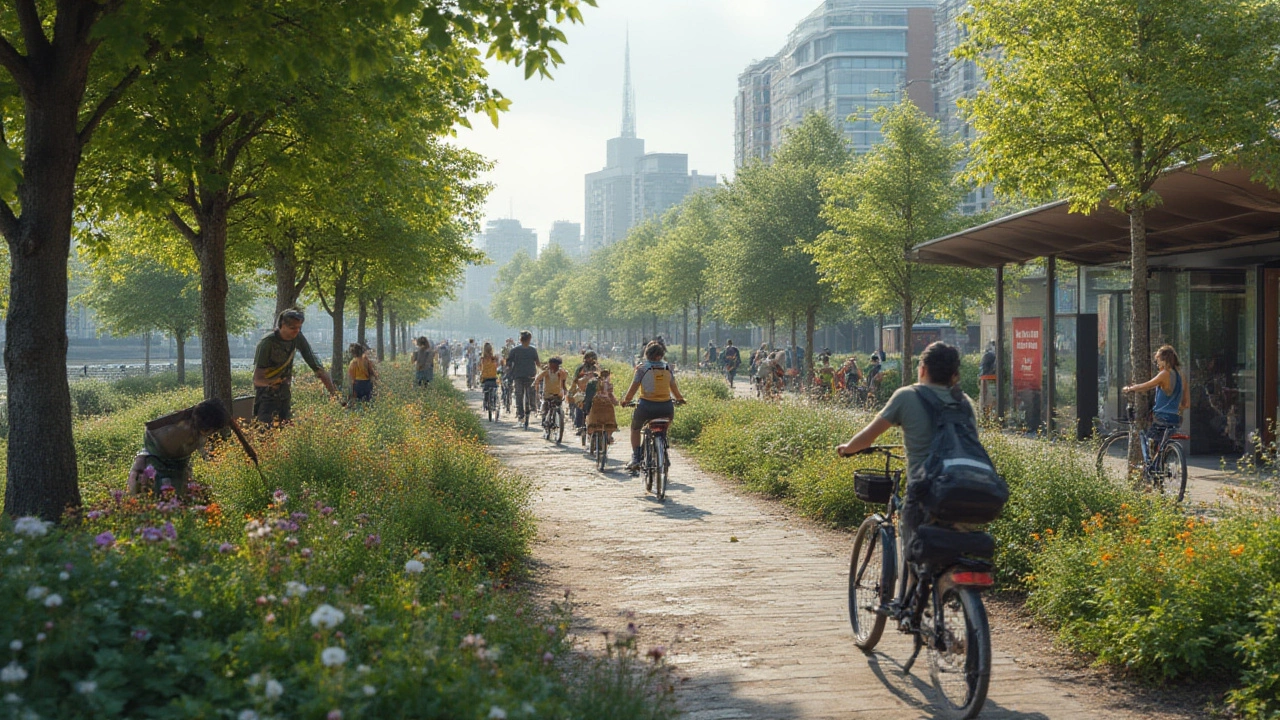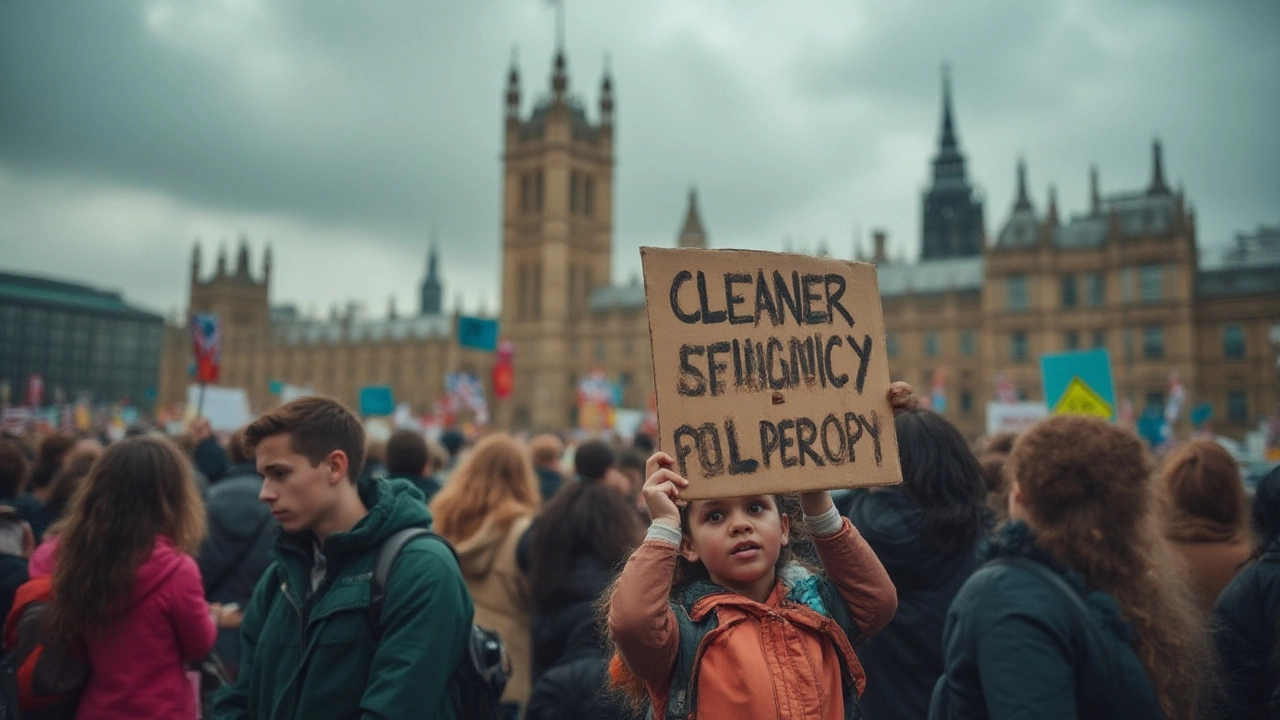How Environmental Groups Make a Real Difference: Actions, Impact, and Strategies
 Jul, 30 2025
Jul, 30 2025
If you ask ten people walking down Princes Street what environmental groups actually do, you'll probably get ten different answers. Some picture folks in waterproofs cleaning up beaches, others think of loud protests in city squares, or maybe campaigns against giant oil companies. Environmental groups are one of those forces that's always there, shaping our world behind the scenes, rarely with enough spotlight. But since 2023, wildfires, heatwaves, and freak storms aren’t letting the rest of us just glance away. These groups aren’t just handing out leaflets—they’re fighting for our lives and the future of cities like Edinburgh, London, and far beyond.
Core Actions: What Environmental Groups Actually Do, Day to Day
Imagine an ordinary day in a bustling environmental organisation based in the UK. Behind the scenes, there’s a lot more going on than headline-grabbing protests. Some teams wake up early to monitor river pollution. For instance, the Scottish Environment Protection Agency regularly records water quality levels, and volunteers help keep rivers like the Water of Leith trouble-free. Others spend hours indoors, reviewing government policies, reading dry documents, and reporting new loopholes big enough to drive diesel trucks through. Remember the time Scotland banned single-use plastics in 2022? A bunch of small, gritty groups kept that busy behind the scenes for years.
Meanwhile, some groups focus on environmental education. They pop into schools, run outdoor workshops, and help the next wave of students understand what climate change really looks like, not just as a chart but through real plants, bugs, and flooding stories. They also set up beach cleanups, tree planting days, and even zero-waste pop-up markets. These events give people something practical to do—an antidote to the doomscrolling, really.
But action doesn’t stop there. Pressure campaigns are a big part of the daily grind. Environmental groups study city council budgets line by line, then launch petitions, lobby councillors, and get media attention when funding for new cycle lanes or renewable energy projects gets slashed. Honest answer? Without these watchdog efforts, quite a few green plans would die quietly before most people even heard about them.
Striking fact: in 2024, Friends of the Earth Scotland managed to get 13,000 signatures to stop a landfill expansion outside Glasgow—proof that campaigns, when powered by real voices, still move the needle.
The Power of Community Engagement: Getting People Involved
Let’s face it, a campaign is only as strong as the community behind it. Environmental groups know that if people care enough to show up—whether it’s a peatland restoration project or a climate march down the Royal Mile—the cause gets momentum. But it takes real work to get neighbours away from the telly and out the door.
Groups like Keep Scotland Beautiful have this down to an art. They don’t just tell people to recycle or switch off their lights. They host hands-on workshops showing you how to fix bikes, repair jeans, or compost properly, so suddenly the “eco-stuff” makes sense and feels doable. The simple act of physically planting a tree, seeing it grow over the seasons, or pulling plastic out of a familiar stream creates ownership. This is how a cause turns from lip-service into something you’d actually defend: because it’s your patch of green, your river, your air.
Community gardens across Edinburgh show what’s possible. In 2025, Leith’s urban garden project had over 1,000 people from 21 different nationalities working together. Not just picking tomatoes, but turning their tiny green plot into an outdoor classroom, gathering spot, and even a place for local businesses to compost food waste. That’s the kind of ripple effect and network-building that formal talks about “resilience” never capture.
There’s more. Successful groups don’t just shout for change—they make it fun. Think eco-festivals, swap shops, and bike rides powered by smoothies made on pedal-blenders. Campaigns powered by music, food, and genuine laughter—these win far more hearts than any guilt trip ever could.

Influencing Policy and the Big Impact Plays
Talking about fun—we also need to talk about politics. Here’s a stat: in 2024, the UK scored its highest ever Environment Performance Index, partly due to relentless nagging (and clever lobbying) by green groups. Bringing this kind of change is never quick. Behind every new government bill to cut emissions, there is often a small team of campaigners writing reports, drafting tough questions for Members of Parliament, and rallying the public to flood inboxes with their demands.
This is where environmental groups have real muscle. They can turn one person’s voice into thousands, turning whispers into a roar. Data from Scottish Government show that, between 2021 and 2024, more than 42% of all environmental petitions submitted to parliament originated, co-authored, or promoted by grassroots groups like Extinction Rebellion Scotland and WWF-UK. This is no fringe activity—these are often the sparks that start the fire.
| Year | Major Environmental Policy Wins | Role of Community Groups |
|---|---|---|
| 2022 | Ban on single-use plastics | Grassroots lobbying, public events, online petition |
| 2023 | Expanded zero-emission transport funding | Data collection, council workshops, testimony at parliament |
| 2024 | Stricter air pollution limits in major cities | Citizen science projects with schoolchildren and residents |
Some victories come quietly. Environmental groups often partner with trade unions, parent associations, or even sports clubs to broaden the conversation. In 2023, Aberdeen FC worked with Surfers Against Sewage to monitor water quality near training pitches after fans noticed an uptick in illnesses. Simple data like this ends up reshaping zoning laws and health guidelines. This is environmental activism by stealth, often more effective than marches or online outrage.
Don’t forget legal action. Organised groups have the funds and clout to sue companies or public bodies when new developments break the rules. The campaign to keep the Tay Estuary free from illegal dumping? Led by local environmental lawyers and funded by three small charities. It pays to know the fine print.
Tools, Tactics, and Fresh Ideas: How Groups Work Smarter
Sustainability isn’t just a buzzword—it’s the playbook for how modern environmental groups operate. Old-school activism (think leaflets and loudspeakers) still helps, but digital tools have changed the game. Who knew the humble WhatsApp group would turn into a key battleground for eco-change in the 2020s?
Volunteer management apps keep projects organised and sign-ups high. Social media pushes urgent updates directly to thousands. For example, in 2025, a flash protest in Edinburgh’s Holyrood Park popped up in under 24 hours, coordinated entirely through group chats and community blogs. These aren’t just clever tricks—they’re how groups stay nimble in the face of constant political and weather surprises.
But sometimes it’s the quieter changes that matter most. Groups like the Royal Society for the Protection of Birds run citizen science projects, training people to count nesting seabirds or monitor woodland health. The data gathered here ends up in government biodiversity reports and influences where millions in funding goes each year.
- Use digital petitions and geotagged reporting apps to spot illegal dumping or sewage outflows. Quick reporting leads to speedy cleanups.
- Partner with local artists to create public murals or installations—these grab attention for green issues among people who’d never join a protest.
- Host webinars and Q&As to break down complicated policies, so everyone feels ready to ask local politicians the tough questions.
- Create repair cafes: these upskill the public while keeping thousands of gadgets and clothes from landfills. Edinburgh’s own Remade Network helped fix over 8,000 items in 2024 alone.
Groups get creative when funding’s tight. Crowdfunding, small grants, and corporate sponsorships keep the engine running. A sharp tip: apply for local council grants—they’re often easier to get with a solid track record of practical, visible community work.
If you want to help your local group, offer your skills—whether it’s graphic design or rallying your mates for a litter-pick. Everyone brings something to the table, and being part of it feels good (though sometimes muddy!).

Challenges to Watch: How Environmental Groups Navigate Setbacks
Nothing about this work is easy. Sometimes the problems feel bigger than their solutions—think oil companies with bottomless legal budgets, or national policies that drag their heels. Edinburgh saw this first-hand in late 2024, when plans for a Low Emission Zone sparked fierce opposition, with some business owners worried about delivery van restrictions. Environmental groups had to meet with critics, adjust strategies, and keep the dialogue open—no easy feat when tempers flare.
Fatigue is real. The same faces (especially volunteers) sometimes carry the load for years, risking burnout. Smart groups mix new faces with seasoned hands, provide proper training, and celebrate the little wins—because keeping hope alive takes effort, not just idealism.
Misinformation campaigns and greenwashing are a constant battle too. Some companies claim they’re going green but do little beyond changing their logos. Environmental groups now use fact-checking campaigns to call out fake claims and teach the public how to spot real action versus PR fluff.
Money always matters. Some grassroots organisations run on shoestring budgets, sometimes struggling just to afford good rain gear or bus money for volunteers. Watts of Love, a UK based group, started running solar light swap events where people could exchange old batteries for new, renewable-powered ones. It’s creative fixes like these that stretch limited funds while deepening community ties.
Staying relevant means being flexible. During the 2023 energy price crisis, groups adapted by running workshops on home insulation and heat pumps—meeting the moment, not just sticking to the old script. That nimbleness makes the difference between real impact and fading into the background.
People ask if environmental groups really have a shot against climate change. The answer? No single group is pulling this off alone, but their combined efforts, especially when powered by ordinary people, have already made cleaner air, safer water, and greener cities a reality. There’s no playbook for saving the world, but there are thousands of committed hands pulling together—and that’s something worth standing behind.
